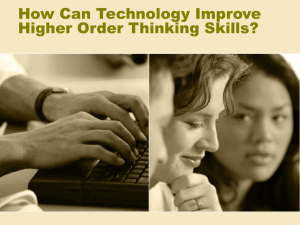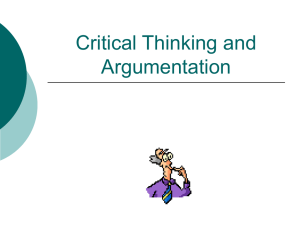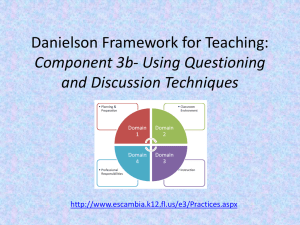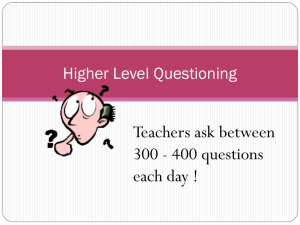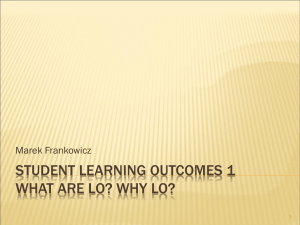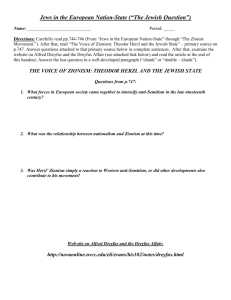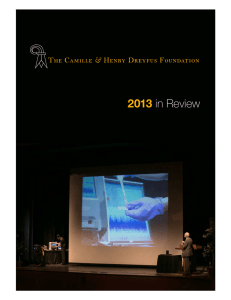Teaching Critical Thinking
advertisement
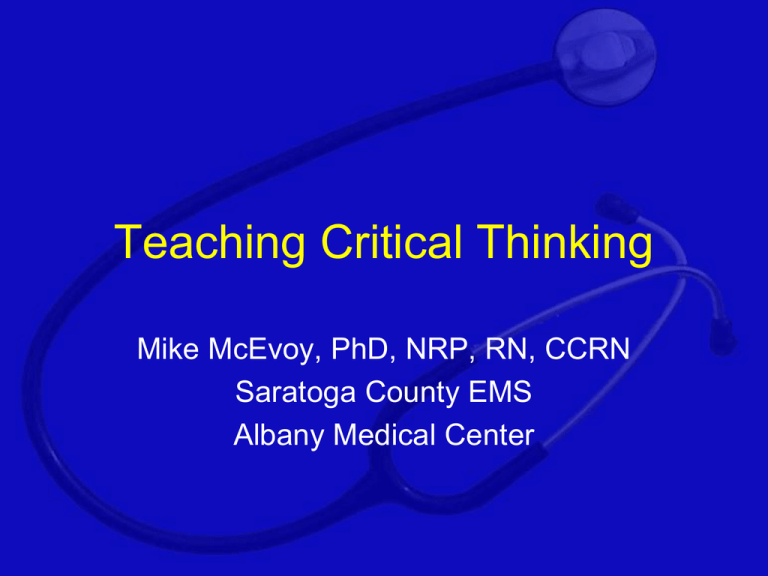
Teaching Critical Thinking Mike McEvoy, PhD, NRP, RN, CCRN Saratoga County EMS Albany Medical Center What is “Critical Thinking”? 1. Higher ordered thinking 2. Question assumptions 3. Decide whether a theory is: – – – – True False Partly true and partly false Sometimes true and sometimes false 4. Requisite for “street ready” graduates Teaching “how to think” versus “what to think” Why Johnny Can’t Read Google • Critical thinking problematic everywhere On Line Research Skills • • • • Google used for 47.3% of all searches Are users savvy to results relevance? 16 Charleston College students (20 yo) Google results randomly swapped or reversed Pang B et al. In Google We Trust: Users Decisions on Rank, Position and Relevance. J Comp-Mediated Comm. 2007:12(3), article 3. http://jcmc.indiana.edu/vol12/issue3/pan.html Students consistently used (falsely) top-ranked pages Dreyfus Model of Skill Acquisition: • • • • • Novice Advanced Beginner Competent Proficient Expert The Dreyfus Model NOVICE: • Cookbook approach (rule governed behavior) – Everything is B & W • • • • Limited and inflexible (sloooow) Lack contextual knowledge Unable to relate training to real events No ability to prioritize tasks Unconsciously Incompetent The Dreyfus Model ADVANCED BEGINNER (1-2 yrs): • • • • • Marginally acceptable performance Beginning to link knowledge with experience Beginning to know when to apply and break rules Patterns emerge – “aspects of the situation” Moves from rules to guidelines – Problems arise when guidelines conflict • Cannot prioritize – needs competent partner to assure important tasks don’t go undone Consciously Incompetent The Dreyfus Model COMPETENT (2-3 yrs)*: • Conscious, deliberate, planning ability (knows what to do, when, why and how to do it) • Can determine what is and is not important • Has a model that can be used as a starting point in most situations • Not yet fast, fluid, efficient, or flexible • Feels mastery and ability to cope • Learn best from simulation * Best preceptors Consciously Competent The Dreyfus Model PROFICIENT (3-5 yrs): • Experienced based ability to see whole situations – uses “maxims” • Readily formulates plans for action • Anticipates “most likely” occurrences • Recognizes departures from the expected course and modifies plans accordingly • Intuitive pattern recognition • Learn best from case studies Unconsciously Competent The Dreyfus Model EXPERT: • Zeroes in on problems without wasteful considerations of alternatives • Anticipates the unusual • Has knowledge not easily available in textbooks • Difficult to capture descriptions of behaviors Reflective EMS Provider The Critical Thinking Process Concept Formation • Info gathered to form general impression • Includes: – – – – – – – Scene assessment Chief complaint History Affect Initial assessment Physical exam Diagnostic tests Data Interpretation • Data gathered • Knowledge – Anatomy and physiology – Pathophysiology • Attitude • Experience Application of Principle • Field impression/working diagnosis • Protocols/standing orders • Treatment/intervention Evaluation • • • • • Patient reassessment Reflection on care given Revision of impression Protocol/standing orders Revision of treatment/intervention Reflection on Action • Run critique • Addition to/modification of student experience base Critical Thinking Detractors: • • • • Protocols SOGs PSE Tendency to test at lower thought levels • Faculty not in clinical practice Critical Thinking Enhancers • Simulation • Story telling • Case reviews (experienced providers) When is Critical Thinking Important? • Rare EMS call = life threat • Minor trauma/medical calls require little critical thinking (easy decisions) • Obvious life threats also not very challenging (fit standard treatments) • Patients between minor and lifethreatening are critical thinking challenges! So, how do I teach critical thinking to newbies? Mental checklists 1. 2. 3. 4. 5. Stop and think Scan the situation Decide and act Maintain control Reevaluate Performance Characteristics of People Under Stress: • • • • • • Reduced awareness of environmental clues Increased sensitivity to signs of anxiety Decreased tolerance for pain and frustration Increased emphasis on performance error Decreased efficiency in mental processing Increased mistakes and injuries Critical Thought Checklist: 1. Read the scene – Environment/dangers – Immediate surroundings/clues – MOI 2. Read the Patient – – – – – Observe (LOC, appearance, position…) Touch (skin, pulse) Talk (CC, new or preexisting…) Assess (Listen, VS…) Identify life threats Critical Thought Checklist: 3. React – Address life threats – Pick most likely cause – Decide the most serious condition present 4. Reevaluate – Detailed assessment – Response to initial management – Any less obvious problems? 5. Revise your plan 6. Review your performance after the call Bloom’s Taxonomy: Modern Day Critical Thinking? • • • • • • Knowledge Comprehension Application Analysis Synthesis Evaluation Memorization or Critical Thinking? 1. The skin layer ______ is composed largely of fat. a. b. c. d. Subcutaneous tissue Subdermis Epidermis Dermis 2. A skateboarder has sustained a “road rash” following a fall. The two external skin layers have been destroyed, leaving a layer largely composed of fat. What is the name of this remaining layer that you see? a. b. c. d. Subcutaneous tissue Subdermis Epidermis Dermis Bloom’s Taxonomy: Modern Day Critical Thinking? • • • • • • Knowledge Comprehension Application Analysis Synthesis Evaluation A patient asks the EMT what the term, “MCI” means. The EMT knows that MCI stands for _______________. Bloom’s Taxonomy: Modern Day Critical Thinking? • • • • • • Knowledge Comprehension Application Analysis Synthesis Evaluation You respond to an MCI. The crew chief of the first arriving ambulance assumes the role of the __________________. Bloom’s Taxonomy: Modern Day Critical Thinking? • • • • • • Knowledge Comprehension Application Analysis Synthesis Evaluation The triage officer at an MCI finds seven patients. Four are tagged “red.” Which of the following would have the highest acuity and therefore require immediate transport? Bloom’s Taxonomy: Modern Day Critical Thinking? • • • • • • Knowledge Comprehension Application Analysis Synthesis Evaluation The EMT at the scene of an MCI must utilize resources efficiently. Of the following patients, which would the EMT elect to not transport first? 1) A 6 year-old with a pulse of 190, a fractured femur, and a rigid abdomen 2) A 73 year-old with a closed head injury and a heart rate of 48 3) A 35 year-old unconscious 38 week gestation pregnant female 4) A 55 year-old firefighter with chest pain and EKG changes Bloom’s Taxonomy: Modern Day Critical Thinking? • • • • • • Knowledge Comprehension Application Analysis Synthesis Evaluation You transport a patient from the scene of an MVC. On arrival at the ED , the nurse replaces your non-rebreather mask with a nasal cannula. The physician removes the patient from the long backboard. Defend their actions using published evidence. One Last Thought: Internet • Are we fostering evidence based practice? • Introduce credible sources • Teach analysis – Who put it there and why • Academic, advocacy group or hobbyist – Currency (date) – Scientific sources cited – Author qualifications and contact info – Reputable third party certification/links – Etc… First year med students Second/third year med students Summary • Critical Thinking is higher ordered thought • Necessary for “Street Ready” providers • Difficult to teach/foster: – Beginners seek black & white, not gray – EMS design very protocol driven • Can be promoted with attention to stories, simulation, case based teaching, better testing • Savvy internet use will promote future evidence based practice in EMS


